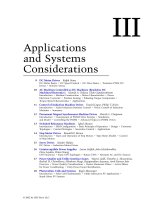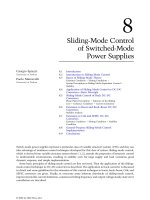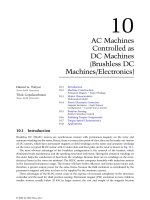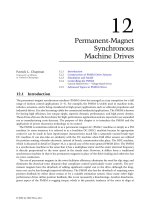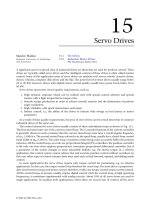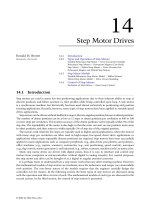Tài liệu Power Electronic Handbook P20 docx
Bạn đang xem bản rút gọn của tài liệu. Xem và tải ngay bản đầy đủ của tài liệu tại đây (597.58 KB, 25 trang )
© 2002 by CRC Press LLC
20
Unified Power
Flow Controllers
20.1 Introduction
20.2 Power Flow on a Transmission Line
20.3 UPFC Description and Operation
Series Converter: Four Modes of Operation • Automatic
Power Control
20.4 UPFC Modeling
UPFC Steady-State or Load Flow Model • UPFC Dynamic
Model • Interfacing the UPFC with the Power Network
20.5 Control Design
UPFC Basic Control Design • Power System Damping
Control through UPFC Using Fuzzy Control
20.6 Case Study
Test System • Tracking Real and Reactive Power
Flows • Operation under Fault Conditions
20.7 Conclusion
20.1 Introduction
An electric power system is an interconnection of generating units to load centers through high-voltage
electric transmission lines. It consists of generation, transmission, and distribution subsystems, which
used to belong to the same electric utility in a given geographical area. But, currently, the electric power
industry is in transition from large, vertically integrated utilities providing power at regulated rates to
an industry that will incorporate competitive companies selling unbundled power at possibly lower rates.
With this new structure, which will include separate generation, distribution, and transmission companies
with an open-access policy, comes the need for tighter control strategies. The strategies must maintain
the level of reliability that consumers not only have taken for granted but expect even in the event of
considerable structural changes, such as a loss of a large generating unit or a transmission line, and loading
conditions, such as the continuous variations in power consumption. The deregulation of electricity that
is taking place now will affect all business aspects of the power industry as known today from generation,
to transmission, distribution, and consumption. Transmission circuits, in particular, will be stretched to
their thermal limits because existing transmission lines are loaded close to their stability limits and
building of new transmission circuits is difficult, if not impossible, at least from environmental and/or
political aspects. New equipment and control devices will be sought to control power flow on transmission
lines and to enhance stability and reliability of the system. Flexible AC transmission systems (FACTS)
and FACTS controllers, which are power electronics devices used to control the power flow and enhance
stability, have become common words in the power industry, and they have started replacing many mechanical
control devices. They are certainly playing an increasingly major role in the operation and control of
Ali Feliachi
West Virginia University
Azra Hasanovic
West Virginia University
Karl Schoder
West Virginia University
© 2002 by CRC Press LLC
today’s power systems. This chapter describes specifically the Unified Power Flow Controller known as
the UPFC. This power electronics device consists of two back-to-back converters operated from a com-
mon DC-link supplied by a capacitor. It is used to control the power flow between two nodes and also
to enhance the stability of the system.
The chapter is organized as follows. First, a brief overview of the power flow on a transmission line
is given. Second, the UPFC is described and its steady-state and basic operations are explained. Third,
steady-state and dynamic models of the UPFC are presented. Also, a procedure to interface the UPFC
with an electric power system is developed. Finally, supplementary signals through the UPFC, designed
using fuzzy logic control tools, are shown to enhance the stability of the system by damping low-frequency
oscillations. A two-area four-generator electric power system is used as a test system.
20.2 Power Flow on a Transmission Line
The power flow on a transmission line connecting two buses
S
and
R
(line sending and receiving buses)
is briefly reviewed. The transmission line, as shown in Fig. 20.1, is modeled by a lumped series impedance,
Z
=
R
+
jX
, where
R
and
X
are the resistance and reactance of the line, respectively.
The complex power,
S
S
, leaving the sending bus and flowing toward the receiving bus is given by
(20.1)
where
=
V
S
∠
δ
S
is the rms phasor voltage of the sending bus
=
the complex conjugate of the phasor current on the line
The real and reactive powers are obtained from the complex power:
(20.2)
The line current, using Ohm’s law, is
(20.3)
where
Therefore, the conductance and susceptance of the line are
Hence, using Eqs. (20.1) and (20.3), the complex conjugate of the complex power is
(20.4)
S
S
V
S
I
Line
∗
⋅=
V
S
I
Line
∗
S
S
P
S
jQ
S
+=
I
Line
V
S
V
R
–
Z
------------------
V
S
V
R
–()YV
S
V
R
–()GjB+()== =
YGjB+
1
Z
---
1
RjX+
---------------
R
R
2
X
2
+
----------------- j
X
R
2
X
2
+
-----------------
–====
G
R
R
2
X
2
+
-----------------
R
X
2
1
R
X
---
2
+
--------------------------------
==
B
X
R
2
X
2
+
-----------------
–
1
X
---
1
R
X
---
2
+
--------------------
–==
S
S
∗
P
S
jQ
S
– V
S
∗
I
S
⋅ V
S
∗
V
S
V
R
–()GjB+()⋅ V
S
2
V
S
∗
– V
R
()GjB+()=== =
© 2002 by CRC Press LLC
Euler’s identity, which states that
V
∠−
δ
=
V
(cos
δ
−
j
sin
δ
), is used to write:
(20.5)
Substituting Eq. (20.5) into Eq. (20.4), the real and reactive powers are obtained:
(20.6)
(20.7)
Similarly, the real and reactive powers received at the receiving bus are
(20.8)
(20.9)
In the above equations
P
R
and
Q
R
represent the powers leaving the receiving bus and flowing toward
the sending bus. The power lost on the line is obtained by subtracting the power received from the power
sent. Therefore, the real and reactive line losses are
(20.10)
(20.11)
For typical transmission lines the reactance
X
is a lot larger than the resistance
R
, i.e., the ratio
R
/
X
is very small and usually the conductance
G
is neglected and the susceptance
B
is approximated with
B
=
−
1/
X
. Using these approximations, Eqs. (20.6) and (20.8) yield the power transmitted over the line
from the sending bus to the receiving bus:
(20.12)
where the angle
δ
=
δ
S
−
δ
R
is called the power angle.
FIGURE 20.1
Transmission line.
V
S
∗
V
R
V
S
d
S
–∠()V
R
d
R
∠()V
S
V
R
d
S
d
R
–()–()∠ V
S
V
R
d
S
d
R
–()cos j d
S
d
R
–()sin–()===
P
S
V
S
2
GV
S
V
R
G
d
S
d
R
–
()cos– V
S
V
R
B
d
S
d
R
–
()sin–=
Q
S
V–
S
2
BV
S
V
R
G
d
S
d
R
–
()sin– V
S
V
R
B
d
S
d
R
–
()cos+=
P
0
P–
R
V
R
2
G– V
S
V
R
G
d
S
d
R
–
()cos V
S
V
R
B
d
S
d
R
–
()sin–+==
Q
0
Q–
R
V
R
2
BV
S
V
R
G
d
S
d
R
–
()sin V
S
V
R
B
d
S
d
R
–
()cos––==
P
L
P
S
P
R
–()– V
S
2
V
R
2
+()G 2V
S
V
R
G
d
S
d
R
–
()cos–==
Q
L
Q
S
Q
R
–()––V
S
2
V
R
2
+()B 2V
S
V
R
B
d
S
d
R
–
()cos+==
P
S
P
R
– P
SR
V
S
V
R
B
d
S
d
R
–
()sin–
V
S
V
R
X
------------
d
S
d
R
–
()sin
V
S
V
R
X
------------
d
()sin P
0
d
()=== = = =
© 2002 by CRC Press LLC
The reactive power sent to the line from both buses is
(20.13)
(20.14)
The average reactive power flow is defined as
(20.15)
Equations (20.12) and (20.15) are the basis for understanding the control of power flow on a trans-
mission line. From Eq. (20.12), it is seen that to increase the amount of real power transmitted over the
line one can:
• Increase the magnitude of the voltages at either end, i.e., voltage support
• Reduce the reactance of the line, i.e., line compensation
• Increase the power angle, i.e., phase shift
One can also reverse the power flow by changing the sign of the power angle; i.e., a positive power
angle will correspond to a power flow from sending to receiving, whereas a negative power angle
δ
R
>
δ
S
will correspond to a power flow from receiving to sending.
Similarly, from Eq. (20.15), it is seen that both voltage magnitudes and line reactance will affect the
reactive power. If both voltage magnitudes are the same, i.e., flat voltage profile, each bus will send half
of the reactive power absorbed by the line. The power flow is from sending to receiving when V
R
< V
S
.
Hence, the four parameters that affect real and reactive power flows are V
S
, V
R
, X, and
δ
. To further
understand this relationship, Eqs. (20.12) and (20.14) can be combined:
(20.16)
This equation represents a circle centered at with a radius V
S
V
R
/X. It relates real and
reactive powers received at bus R to the four parameters: V
S
, V
R
,
δ
, X. To see, for example, how the power
angle
δ
affects P
0
and Q
0
, assume that V
S
= V
R
= V and V
2
/X = 1. The P-Q locus for this case is shown
in Fig. 20.2 (solid line). For a specific power angle
δ
, values of P
0
and Q
0
can be found, e.g., if
δ
=
π
/4
(point A on the circle) then P
0A
= 0.707 and Q
0A
= −0.293. Reducing the line reactance X, say to X′ < X,
while keeping V
S
= V
R
= V, will increase the radius of the circle (dashed line). Note that the power angle
δ
might be constrained by stability limits.
Similarly, the relationship between the real and reactive powers sent to the line from the sending bus
S can be expressed as
(20.17)
20.3 UPFC Description and Operation
The UPFC is one of the most complex FACTS devices in a power system today. It is primarily used for
independent control of real and reactive power in transmission lines for a flexible, reliable, and economic
operation and loading of power systems. Until recently all four parameters that affect real and reactive
power flow on the line, i.e., line impedance, voltage magnitudes at the terminals of the line, and power
angle, were controlled separately using either mechanical or other FACTS devices such as a static var
Q
S
V–
S
2
BV
S
V
R
B
d
S
d
R
–
()cos+
V
S
2
V
S
V
R
d
()cos–
X
------------------------------------------
==
Q
R
V
R
2
– BV
S
V
R
B
d
S
d
R
–
()cos+
V
R
2
V
S
V
R
d
()cos–
X
------------------------------------------
Q
0
d
()–===
Q
SR
Q
S
Q
R
–
2
-------------------
V
S
2
V
R
2
–()B
2
----------------------------
–
V
S
2
V
R
2
–
2X
-------------------
== =
P
0
d()()
2
Q
0
(d )
V
R
2
X
-------+
2
+
V
S
V
R
X
------------
2
=
(0, V
R
2
/X)– ,
P
S
d()()
2
Q
S
d()
V
S
2
X
-------–
2
+
V
S
V
R
X
------------
2
=
© 2002 by CRC Press LLC
compensator (SVC), thyristor-controlled series compensation (TCSC), a phase shifter, etc. However, the
UPFC allows simultaneous or independent control of all four parameters, with possible switching from
one control scheme to another in real time. Also, the UPFC can be used for voltage support and transient
stability improvement by damping of low-frequency power system oscillations.
The UPFC is a device placed between two buses referred to as the UPFC sending bus and the UPFC
receiving bus. It consists of two voltage-sourced converters (VSCs) with a common DC-link. For the
fundamental frequency model, the VSCs are replaced by two controlled voltage sources as shown in Fig. 20.3.
By applying the pulse width modulation (PWM) technique to the two VSCs, the following equations
for magnitudes of shunt and series injected voltages can be obtained [2]:
(20.18)
where
m
SH
= amplitude modulation index of the shunt VSC control signal
m
SE
= amplitude modulation index of the series VSC control signal
n
SH
= shunt transformer turn ratio
n
SE
= series transformer turn ratio
V
B
= the system side base voltage in kV
V
DC
= DC-link voltage in kV
FIGURE 20.2 P-Q locus of the uncompensated system.
V
SH
m
SH
V
DC
22n
SH
V
B
-------------------------
=
V
SE
m
SE
V
DC
22n
SE
V
B
------------------------
=
© 2002 by CRC Press LLC
The phase angles of and are
(20.19)
where
ϕ
SH
= firing angle of the shunt VSC with respect to the phase angle of the sending bus voltage
ϕ
SE
= firing angle of the series VSC with respect to the phase angle of the sending bus voltage
The voltage source at the sending bus is connected in shunt and will therefore be called the shunt voltage
source. The second source, the series voltage source, is placed between the sending and the receiving buses.
Both voltage sources are modeled to inject voltages of fundamental power system frequency only. The UPFC
is placed on high-voltage transmission lines. This arrangement requires step-down transformers to allow the
use of power electronic devices for the UPFC. The transformer impedances have been included in the model.
The series converter injects an AC voltage = V
SE
∠(
δ
S
−
ϕ
SE
) in series with the transmission line.
The series voltage magnitude V
SE
and its phase angle
ϕ
SE
with respect to the sending bus are controllable
in the range of 0 ≤ V
SE
≤ V
SE max
and 0 ≤
ϕ
SE
≤ 360°. The shunt converter injects controllable shunt voltage
such that the real component of the current in the shunt branch balances the real power demanded by
the series converter. The reactive power cannot flow through the DC-link. It is absorbed or generated
(exchanged) locally by each converter. The shunt converter operated to exchange the reactive power with
the AC system provides the possibility of independent shunt compensation for the line. If the shunt-
injected voltage is regulated to produce a shunt reactive current component that will keep the sending
bus voltage at its prespecified value, then the shunt converter is operated in the automatic voltage control
mode. The shunt converter can also be operated in the VAr control mode. In this case, shunt reactive
current is produced to meet the desired inductive or capacitive VAr request.
Series Converter: Four Modes of Operation
As mentioned previously, the UPFC can control, independently or simultaneously, all parameters that
affect power flow on a transmission line. This is illustrated in the phasor diagrams shown in Fig. 20.4 [3].
FIGURE 20.3 Fundamental frequency UPFC model.
V
SH
V
SE
d
SH
d
S
j
SH
–=
d
SE
d
S
j
SE
–=
V
SE
© 2002 by CRC Press LLC
Voltage regulation is shown in Fig. 20.4a. The magnitude of the sending bus voltage is increased
(or decreased) by injecting a voltage of maximum magnitude V
1max
, in phase (or out of phase) with
Similar regulation can be accomplished with a transformer tap changer.
Series reactive compensation is shown in Fig. 20.4b. It is obtained by injecting a voltage of
maximum magnitude V
2max
, orthogonal to the line current The effective voltage drop across the
line impedance X is decreased (or increased) if the voltage lags the current by 90° (or leads
current by 90°).
A desired phase shift is achieved by injecting a voltage of maximum magnitude V
3max
, that shifts
the phase angle of by ±
θ
while keeping its magnitude constant as shown in Fig. 20.4c.
Simultaneous control of terminal voltage, line impedance, and phase angle allows the UPFC to perform
multifunctional power flow control. The magnitude and the phase angle of the series injected voltage
= + + shown in Fig. 20.4d, are selected in a way to produce a line current that will
result in the desired real and reactive power flow on the transmission line.
Therefore, the UPFC series converter can be operated in any of the following four modes:
1. Voltage regulation
2. Line compensation
3. Phase angle regulation
4. Power flow control
Automatic Power Control
The automatic power control mode cannot be accomplished with conventional compensators. To show how
line power flow can be affected by the UPFC operated in the automatic power flow control mode, a UPFC
is placed at the beginning of the transmission line connecting buses S and R as shown in Fig. 20.5 [3]. Line
conductance is neglected. UPFC is represented by two ideal voltage sources of controllable magnitude
and phase angle. Bus S and fictitious bus S
1
shown in Fig. 20.5 represent the UPFC sending and receiving
buses, respectively.
In this case, the complex power received at the receiving end of the line is given by
(20.20)
where = V
SE
∠ (
δ
S
−
ϕ
SE
).
FIGURE 20.4 Phasor diagrams.
V
S
V
1
,
V
S
.
V
2
,
I
Line
.
V
2
I
Line
V
2
I
Line
V
3
,
V
S
V
SE
V
1
V
2
V
3
,
SV
R
I
Line
∗
V
R
V
S
V
SE
V
R
–+
jX
--------------------------------
∗
==
V
SE
© 2002 by CRC Press LLC
The complex conjugate of this complex power is
(20.21)
By performing simple mathematical manipulations and separating real and imaginary parts of Eq. (20.21),
the following expressions for real and reactive powers received at the receiving end of the line are
(20.22)
For V
SE
= 0 the above equations are identical to Eqs. (20.12) and (20.14) that represent the real and
reactive powers of the uncompensated system.
It was stated previously that the UPFC series voltage magnitude can be controlled between 0 and V
SE max
and its phase angle can be controlled between 0 and 360° at any power angle
δ
. It can be seen from
Eq. (20.21) that the real and reactive power received at bus R for the system, when a UPFC is installed,
can be controlled between
(20.23)
where
FIGURE 20.5 Transmission line with UPFC.
S
∗
PjQ– V
R
∗
V
S
V
SE
V
R
–+
jX
--------------------------------
==
P
V
S
V
R
X
------------
dsin
V
R
V
SE
X
--------------
dj
SE
–()sin+ P
0
d() P
SE
d, j
SE
()+==
Q
V
R
2
X
-------–
V
S
V
R
X
------------
dcos
V
R
V
SE
X
--------------
dj
SE
–()cos+ Q
0
d() Q
SE
d, j
SE
()+=+=
P
min
d() PP
max
d()≤≤
Q
min
d() QQ
max
d()≤≤
P
min
d() P
0
d()
V
R
V
SEmax
X
---------------------–=
P
max
d() P
0
d()
V
R
V
SEmax
X
---------------------+=
Q
min
d() Q
0
d()
V
R
V
SEmax
X
---------------------–=
Q
max
d() Q
0
d()
V
R
V
SEmax
X
---------------------+=
© 2002 by CRC Press LLC
Rotation of the series injected voltage phasor with rms value of V
SE max
from 0 to 360° allows the real
and the reactive power flow to be controlled within the boundary circle with a radius of V
R
V
SE max
/X and
the center at (P
0
(
δ
), Q
0
(
δ
)). This circle is defined by the following equation:
(20.24)
Figure 20.6 shows plots of the reactive power Q demanded at the receiving bus vs. the transmitted real
power P as a function of the series voltage magnitude V
SE
and phase angle
ϕ
SE
at three different power
angles
δ
, i.e.,
δ
= 0°, 45°, and 90°, with V
S
= V
R
= V, V
2
/X = 1 and V
R
V
SE max
/X = 0.5 [3]. The capability
of the UPFC to control real and reactive power flow independently at any transmission angle is clearly
illustrated in Fig. 20.6.
20.4 UPFC Modeling
To simulate a power system that contains a UPFC, the UPFC needs to be modeled for steady-state and
dynamic operations. Also, the UPFC model needs to be interfaced with the power system model. Hence,
in this section modeling and interfacing of the UPFC with the power network are described.
UPFC Steady-State or Load Flow Model
For steady-state operation the DC-link voltage remains constant at its prespecified value. In the case of
a lossless DC-link the real power supplied to the shunt converter P
SH
= Re satisfies the real
power demanded by the series converter P
SH
= Re
(20.25)
FIGURE 20.6 P-Q relationship for a simple two-bus system with a UPFC at
δ
= 0°, 45°, and 90°.
P d, j
SE
()P
0
d()–()
2
Q d, j
SE
()Q
0
d()–()
2
+
V
R
V
SEmax
X
---------------------
2
=
(V
SH
I
SH
∗
)
(V
SE
I
Line
∗
)
P
SH
P
SE
=
© 2002 by CRC Press LLC
The LF model discussed here assumes that the UPFC is operated to keep (1) real and reactive power
flows at the receiving bus and (2) sending bus voltage magnitude at their prespecified values [4]. In this
case, the UPFC can be replaced by an “equivalent generator” at the sending bus (PV-type bus using LF
terminology) and a “load” at the receiving bus (PQ-type bus) as shown in Fig. 20.7.
To obtain the LF solution of a power network that contains a UPFC, an iterative procedure is needed.
Power demanded at the receiving bus is set to the desired real and reactive powers at that bus. The real
power injected into a PV bus for a conventional LF algorithm is kept constant and the reactive power is
adjusted to achieve the prespecified voltage magnitude. With a UPFC, the real power injected into the
sending bus is not known exactly. This real power injection is initialized to the value that equals the
prespecified real power flow at the receiving bus. During the iterative procedure, the real powers adjusted
to cover the losses of the shunt and series impedances and to force the sum of converter interaction to
become zero. The algorithm, in its graphical form, is given in Fig. 20.8.
The necessary computations are described next. The complex power injected into sending bus is
(20.26)
Using the voltages and currents described in Fig. 20.3
(20.27)
results in
(20.28)
FIGURE 20.7 Power network with a UPFC included: (a) schematic; (b) LF model.
S
S
V
S
I
S
∗
=
V
S
V
SH
V
Z
SH
+=
V
ZSH
I
SH
Z
SH
=
I
S
I
SH
– I
Line
–=
S
S
V
SH
V
Z
SH
+()I
SH
I
Line
––()
∗
=
V
SH
– I
SH
∗
V
ZSH
I
SH
∗
– V
SH
I
Line
∗
– V
Z
SH
I
Line
∗
–=
V–
SH
I
SH
∗
Z
SH
I
SH
2
– V
SH
I
Line
∗
– Z
SH
I
SH
I
Line
∗
–=

